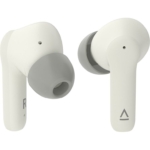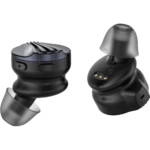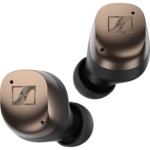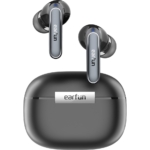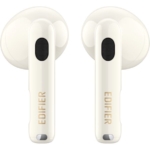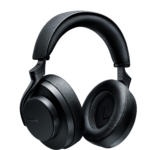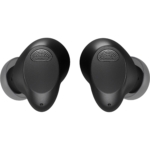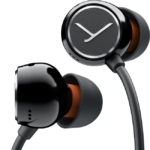With the OpenFit, Shokz offer open True-Wireless headphones whose strengths are in communication and exemplary wearing comfort; at the same time, they definitely offer quality music playback with appealing results.
- first class choice for communication
- high wearing comfort
- no multi-pairing
Today, headphones are no longer just for transporting music to the ears. Instead, they are often an essential tool for work, communication in general, mobile and sports use. With OpenFit, Shokz introduces a True-Wireless solution that focuses on communication.
The Chinese manufacturer Shokz, formerly AfterShokz, is much bigger than you might think. A considerably large team of engineers is involved in the development of headphones and already holds several patents. Shokz is particularly known for headphones that work according to the principle of bone sound conduction and have found a clientele in the sports market. However, this is not the case with OpenFit. Nevertheless, these True-Wireless headphones also have the advantage of not blocking the auditory canal.
What can the Shokz OpenFit do?
The featherweight design has an exceptionally soft surface and hangs over the back of the ear. According to the manufacturer, “liquid silicone” with a hardness grade of 0 is used, which assumes body temperature and will not become annoying. Unlike the competition, no sound transducer is placed in the auditory canal. Instead, the ear remains free and thus, exchange with the environment and other people is more possible. The accompanying specially developed dynamic driver (18 x 11 mm) almost floats in front of the auditory canal. A dynamic digital equalisation (OpenBass) levels the sound emitted towards the ear with the aim of achieving as complete a frequency response as possible, and this is quite demanding, especially in the bass range. Conversely, the technology called “DirectPitch” ensures that the sound in other directions remains inconspicuous and does not disturb the surroundings. In other words, the sound is projected by the drivers in exactly the desired direction, just as it is from arrays in live sound systems, for example.
Design of the Shokz OpenFit
The headphones and charging case are available in either matt black or beige and looked modern and high-quality to me. The charging case has a USB-C port, a status LED and the ability to charge inductively. The headphones are inserted against each other in an interlocked manner, which allows the case to be laid flat; it also has a wide lid.
The earpieces themselves are very light at eight grams each and certified to IP54 against splashing water and sweat, making them perfectly suitable for sports use.
Technology in the Shokz OpenFit
Technically, the OpenFit rely on Bluetooth 5.2 and the audio codecs SBC and AAC. A noise suppression system is also used, and this is explicitly dedicated to call quality during telephone conversations. In addition to beamforming microphones, an AI-supported algorithm is used to suppress background noise with a hit rate of over 99 per cent.
Depending on volume, Shokz claims the runtime to be seven hours for the earpieces and 28 hours using the capacity of the charging case. The latter has a quick-charging function.
Of course, an app for further configuration and firmware updates (as of 0.9) should not be missed and is available free of charge for both iOS and Android.
Shokz OpenFit in practice
The wearing comfort is high thanks to the lightweight bracket construction and soft silicone. The earpieces are hardly noticeable, even when worn for many hours. In practice, I sometimes even forgot that I was wearing the headphones. The occasionally disturbing feeling of having “something in my ear” was missing.
The bracket ensures secure positioning, but you should practise placing the headphones correctly in front of the ear, as incorrect positioning is punished with poorer sound, just like with in-ears.
In principle, the OpenFit may not be everyone’s cup of tea due to its concept. In particular, if you’re hoping for isolation from the outside world when listening to music, you will be disappointed. But the reverse is also true: If you want to be in constant exchange with the environment but don’t want to do without music, you should take a closer look at this model. OpenFit is an excellent solution for the office, communication and the general perception of the environment with headphones on. Conversations can be conducted at a comparatively low volume. The call quality was indeed really good and clear. This also applied to the isolation of extraneous noise. However, I consider 99 per cent filter quality to be somewhat exaggerated because strong wind noise definitely affected the quality of the transmission. Nevertheless, a convincing result.
I would describe the range and stability of the wireless link, as well as the runtime, as practical. You can move around freely enough in the office and manage everyday life and longer trips with these batteries. I can also confirm that you don’t disturb the people sitting next to you, as long as you don’t turn up the volume too high. However, points are deducted for the lack of multi-pairing for everyday office use.
The button commands on the unit are configurable but limited to double-click and press-and-hold, which reduces the number of usable functions. In principle, music playback, track jumps, volume and a voice assistant can be controlled and, of course, phone calls. Finally, the well-designed app offers the advantage of a storable equaliser with which the sound can be adjusted to one’s own taste and different situations.
How do the Shokz OpenFit sound?
You shouldn’t expect audiophile hi-fi sound from the Shokz OpenFit. The basic concept with a full-range driver that emits directional sound into the ear with DSP support is not suitable for this. Nevertheless, the sound reproduction succeeds with surprisingly good results, considering that a “transparency mode” is constantly active. The sound is coherent and balanced, with a wide stereo panorama and appealing detail resolution.
A sensible bass foundation is offered, where, for example, even the graduated 808 bass drums on Adel Tawil’s “Katsching” can be detected. In the low bass, however, the OpenFit has to give up. An unfortunate feature: On Rihanna’s “Pon de Replay”, low-frequency distortions from the driver can be heard throughout the song, and these only disappear when the lower frequencies are lowered significantly in the app’s equaliser. Fortunately, this effect did not occur with other bass-heavy tracks.
In the mid-range, I can attest to a pleasant timbre in voices and acoustic instruments, even if I missed some warmth in the low-mids. Dense pop and rock productions were also completely satisfactory and had an appealing pressure from medium levels. Dynamic music, such as orchestral recordings, on the other hand, was not as good. The highs were not obtrusive but quite detailed and coherent. They contributed to the well-decorated stereo image. The bass, on the other hand, was not very pronounced.
Something I also noticed: The Shokz OpenFit sounded good even at low levels, as long as you don’t go below a certain limit because then the reproduction “disintegrates” unattractively. Conversely, a higher level was required for the necessary pressure. In principle, the louder the environment, the louder the headphone level must be. Here it was important to find the right level depending on the situation because the simultaneous evaluation of music and ambient noise or even conversations demanded a certain amount of effort, at least for me. In my case, music playback of acceptable quality required a certain minimum level. If, on the other hand, the need to communicate is in the foreground, I preferred quiet music playback, which becomes the background function, so to speak. And it was precisely this ability that I valued so highly in the Shokz OpenFit.
Conclusion
Shokz are pursuing a thoroughly interesting concept with the OpenFit. These True-Wireless headphones become part of everyday life. In a way, they were able to harmonise music, phone calls, general communication and perception of surroundings. If necessary, they still delivered adequate quality in music playback but could also discreetly banish it to the background. The most important aspect was that these headphones are not simply a distraction, whether you are at home, in the office, outdoors or playing sports.
The competitors in this market are few. The cheaper Sony LinkBuds WF-L900, for example, can be worn as an open construction in the ear. In terms of wearing comfort and performance, however, I see the OpenFit as having the advantage over them. Shokz’s own products, such as the OpenRun Pro, focus more on the sports sector and are at a disadvantage in terms of sound quality via bone sound conduction. OpenFit is what I would call a pretty clever approach to headphones.
Technical specifications
- Ear couplingOpen-Ear
- Typeopen
- Transducer principledynamic
- Frequency response (headphones)50 - 16.000 Hz
- Weight without cable8,3 g each, case 57 g
What's in the box
- USB-C charging cable
- charging case












